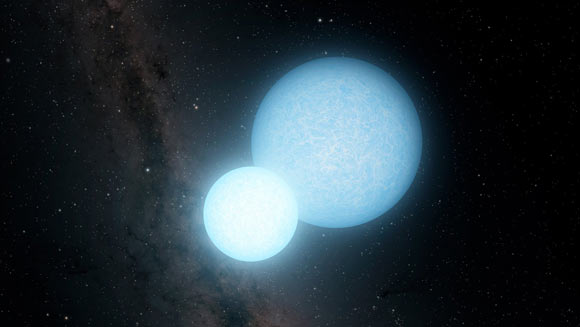Astronomers Discover Record-Breaking White Dwarf Binary System | Astronomy – Sci-News.com
Astronomers using the KPED (Kitt Peak Electron Multiplying CCD demonstrator) instrument at NSF’s Kitt Peak National Observatory have discovered ZTF J153932.16+502738.8, a white dwarf eclipsing binary with the shortest orbital period known to date. Located nearly 8,000 light-years away in the constellation of Boötes, the system is also the second fastest pair of orbiting white dwarfs found to date.

An artist’s impression of a pair of orbiting white dwarfs, ZTF J153932.16+502738.8. Image credit: Caltech / IPAC.
“White dwarf binaries with very tight orbits are expected to be strong sources of gravitational wave radiation. Although anticipated to be relatively common, such systems have proven elusive, with only a few identified to date,” the researchers said.
“Caltech’s Zwicky Transient Facility (ZTF), a new survey of the night sky, currently underway at Kitt Peak National Observatory and Palomar Observatory, is changing this situation.”
ZTF J153932.16+502738.8 (J1539 for short) is comprised of two white dwarfs that circle each other every 6.91 minutes.
The system has an orbit so compact that the entire binary could fit within the diameter of the planet Saturn.
“As the dimmer star passes in front of the brighter one, it blocks most of the light, resulting in the seven-minute blinking pattern we see in the data,” said lead author Kevin Burdge, a graduate student at Caltech.
Closely orbiting white dwarfs are predicted to spiral together closer and faster, as the system loses energy by emitting gravitational waves.
“Sometimes these binary white dwarfs merge into one star, and other times the orbit widens as the lighter white dwarf is gradually shredded by the heavier one,” said Dr. James Fuller, a theoretical astrophysicist at Caltech.
“We’re not sure what will happen in this case, but finding more such systems will tell us how often these stars survive their close encounters.”
J1539’s orbital period is predicted to become measurably shorter after only a few years.
Burdge and colleagues were able to confirm the prediction from general relativity of a shrinking orbit, by comparing their new results with archival data acquired over the past ten years.
“J1539 is a rare gem. It is one of only a few known sources of gravitational waves that will be detected by the future European space mission LISA (Laser Interferometer Space Antenna), which is expected to launch in 2034,” they noted.
Another mystery they hope to answer in the future involves the temperature of the hotter white dwarf, which is estimated to be 90,000 degrees Fahrenheit (50,000 degrees Celsius).
This white dwarf is thought to be so hot because it is starting to ‘feed’ off its companion and pull material onto it, a process that heats material to sizzling-hot temperatures. But this feeding, or accretion process, is usually associated with X-rays, and the scientists are not seeing any.
“It’s strange that we aren’t seeing X-rays in this system. One possibility is that the accretion spots on the white dwarf — the areas the material is falling on — are bigger than what is typical, and this could result in the emission of ultraviolet light and optical light instead of X-rays,” Burdge said.
The discovery is described in a paper published in the July 25, 2019 issue of the journal Nature.
_____
Kevin B. Burdge et al. 2019. General relativistic orbital decay in a seven-minute-orbital-period eclipsing binary system. Nature 571: 528-531; doi: 10.1038/s41586-019-1403-0





